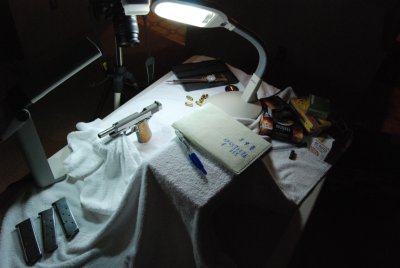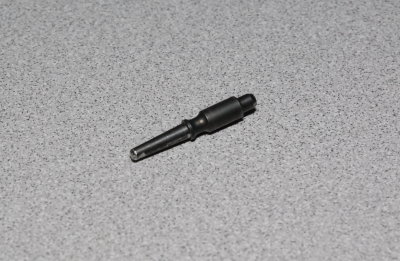Read My Lips
Cannon Fodder
Theory and Setup
Results
Conclusions
More articles
Discuss this article at

Testbed
One issue that bothered me with the last magazine analysis was the inconsistent angle of photography from shot to shot. The photos were taken by a hand-held camera while holding the 1911 with my other hand. Getting the slide into position and trying to keep it steady for a macro shot precluded consistency consistency; furthermore, it was an exercise in frustration made bearable only by the limited scope of the prior analysis. Three different magazine types time nine varieties of ammunition equals a real need to make things easy on myself.

The easy way.
The above photo shows the test setup. The 1911 is supported by a small vise and a tripod-mounted camera is aimed at the ejection port for an optimal view of the action. The butt of the gun sits atop a small piece of tape to ensure that it's lined up the same way for each shot. Two full-spectrum lamps and a flash with diffuser were required to properly light things; even so, the first set of photos, 150 in total, had to be discarded due to improper lighting and angle and all the photos taken again. (You may have heard the howls of frustration.)
The notepad visible in the above photo was used to keep track of what was being photographed. Another problem that I ran into while taking photos for the last article was the headache of trying to match up photos with the notes I'd taken of what had been photographed. This time around, I embedded that information in the photo sequence by writing down what was about to be photographed on the notepad and then snapping a picture of the pad.
A most informative photo.
Safety First
Two of the rounds tested used component bullets loaded into empty, unprimed cases; the remainder, though, were live rounds. Given that the entire point of these tests was to assess behavior when chambering, that meant that I'd be putting the gun into battery with live ammo repeatedly. Theoretically, enough caution would prevent accidents, but blind faith in one's own competence is found soley among the incompetent.

An incompetent firing pin.
In order to prevent any pesky 0.452-inch holes in things, I introduced an old firing pin to a slightly newer hacksaw. The truncated pin would fit into the firing pin channel and hold the firing pin stop in place, but was far too short to hit the primer.
Gun
As with the last set of magazine tests, a Springfield Armory Mil-Spec in stainless steel was used. This 1911, although it has some issues with respect to the slide/barrel clearance, is pretty much in spec where the frame and barrel ramps are concerned; magazine feeding would be represented under correct conditions.

Stainless Mil-Spec with burlwood grips.
In addition to its neutered firing pin, the recoil spring and guide were removed to permit incrementally positioning the slide for feeding.
Controlled Feed
Before getting into the details of the feeding tests performed, it's necessary to recap the principles of controlled feed. The 1911 (or any other semi-automatic handgun chambered in .45 ACP) has the unenviable task of feeding a short, fat round as reliably as possible. The cartridge to be fed has to sit at least partly below the bore axis in order to avoid interference with the cartridge being extracted and ejected. The wider the cartridge, the farther it has to move upwards during feeding. The problem of cartridge width is compounded by its relatively short length. Not only does the top round in the magazine have to move quite a ways up, but it has relatively little horizontal distance in which to do so.
There are two general approaches to feeding .45 ACP (or any other cartridge) reliably. One can make the chamber as easy a target as possible, move the top cartridge in the magazine as high up as possible, and use the forward travel of the slide to fling the cartridge into the chamber. Glocks in all calibers represent the perfection of this technique and even some 1911 magazines attempt to replicate it to work around bad feed geometry. Uncontrolled feed works well enough that many guns use it, but this uncontrolled feed has its drawbacks: It's highly dependent on slide inertia relative to magazine spring strength and it introduces a large element of kinetically-sensitive randomness into the feed cycle. Although usually not a problem, uncontrolled feed can produce maddeningly random and unrepeatable errors followed by thousands of rounds of perfectly reliable performance. On the other hand, it's fairly easy to make relatively reliable uncontrolled-feed handguns: By definition, the tolerances are generous and forgiving.
Controlled-feed firearms take the opposite approach, pursuing reliability through predictability. The 1911 epitomizes this approach. Rather than type up a blow-by-blow description of what goes on during 1911 feeding, I recommend you read this writeup for details. It's a complicated read, but worth the time. Controlled feed relies on precise relationships between all parts and involved. Failing to meet specifications can cause controlled feed to devolve into uncontrolled feed or, in the worst case, make a controlled-feed handgun jam in ways uncontrolled feed would not. The only advantage to an out-of-spec controlled-feed system is that failures are usually repeatable, which makes them easier to diagnose. But when the specified dimensions are met, there's only one variable in a controlled-feed system: the magazine.
email: hidi.projects at gmail.com